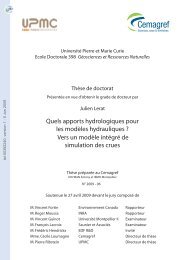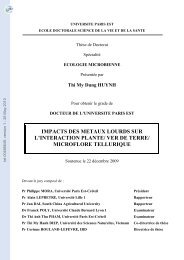La conservation de la nature en Afrique centrale entre théorie et ...
La conservation de la nature en Afrique centrale entre théorie et ...
La conservation de la nature en Afrique centrale entre théorie et ...
- No tags were found...
Create successful ePaper yourself
Turn your PDF publications into a flip-book with our unique Google optimized e-Paper software.
tel-00508990, version 1 - 9 Aug 2010VII.1. LE PROJET DE GESTION MIS EN ŒUVRE AU NIVEAU DE ZAKOUMA .......................................... ‐ 261 ‐Zoom sur <strong>la</strong> gran<strong>de</strong> faune sauvage ............................................................................‐ 264 ‐Une rhétorique fondée sur l’intégration <strong>conservation</strong>/développem<strong>en</strong>t ....................‐ 266 ‐Vol<strong>et</strong> développem<strong>en</strong>t rural du proj<strong>et</strong> <strong>de</strong> <strong>conservation</strong>............................................... ‐ 266 ‐VII. 2. AMENAGEMENT DE L’ESPACE ....................................................................................... ‐ 269 ‐Les migrations <strong>de</strong> <strong>la</strong> gran<strong>de</strong> faune .............................................................................‐ 269 ‐Contrôle <strong>de</strong>s dynamiques <strong>en</strong> périphérie du PNZ ........................................................‐ 269 ‐P<strong>la</strong>ns <strong>de</strong> développem<strong>en</strong>t local :..................................................................................‐ 276 ‐⇒ Composition <strong>de</strong> l’Unité <strong>de</strong> coordination :..................................................‐ 276 ‐⇒ Contrôle <strong>de</strong> l’exploitation <strong>de</strong>s ressources <strong>nature</strong>lles :...............................‐ 278 ‐Modalités institutionnelle pour <strong>la</strong> mise <strong>en</strong> p<strong>la</strong>ce du zonage ......................................‐ 280 ‐⇒ Réaction <strong>de</strong>s acteurs étatiques ..................................................................‐ 283 ‐⇒ Ateliers <strong>de</strong> validation.................................................................................. ‐ 283 ‐VII. 3. BILAN DES IMPACTS DU DISPOSITIF D’AMENAGEMENT. QUELS RETOMBEES ET RISQUES POUR LESPOPULATIONS LOCALES ......................................................................................................... ‐ 284 ‐R<strong>et</strong>ombées pour les popu<strong>la</strong>tions ................................................................................‐ 284 ‐Risques pour les popu<strong>la</strong>tions ...................................................................................... ‐ 285 ‐⇒ Risque sociopolitique <strong>et</strong> instrum<strong>en</strong>talisation ............................................‐ 285 ‐⇒ Risques d’ordre socioéconomique .............................................................‐ 286 ‐⇒ « Lissage » <strong>de</strong> <strong>la</strong> réalité socio‐économique ................................................‐ 287 ‐⇒ Prégnance <strong>de</strong>s conflits fonciers – dynamiques foncières locales <strong>et</strong> supravil<strong>la</strong>geoises ......................................................................................................... ‐ 287 ‐Implications locales .................................................................................................... ‐ 294 ‐EN RESUME… ............................................................................................................... ‐ 295 ‐ASSUMER LES IMPACTS FONCIERS DU PLAN D’AMENAGEMENT ? .................................................... ‐ 295 ‐INTEGRER LES LOGIQUES, PRATIQUES ET MECANISMES ENDOGENES ? ............................................. ‐ 296 ‐PRENDRE EN COMPTE LA MOBILITE, COMPOSANTE CLE DES DYNAMIQUES LOCALES ? ......................... ‐ 297 ‐ACCOMPAGNER LA DIFFICILE COHABITATION HOMME/FAUNE ? ..................................................... ‐ 298 ‐CONCLUSION DE LA DEUXIEME PARTIE ........................................................................ ‐ 299 ‐PARTIE 3 ......................................................................................................................‐ 300 ‐LE CONTROLE DES ESPACES A ENJEUX ..........................................................................‐ 300 ‐DE CONSERVATION ......................................................................................................‐ 300 ‐CHAPITRE 8 ..................................................................................................................‐ 302 ‐LA STANDARDISATION DES OUTILS DE MISE EN ŒUVRE DE LA CONSERVATION INTEGREE .. ‐302 ‐VIII. 1. DES APPROCHES PARTICIPATIVES QUI CONSOLIDENT LES RAPPORTS DE FORCE AUTOUR DES ESPACES DECONSERVATION ................................................................................................................... ‐ 302 ‐Des dispositifs exogènes qui rêv<strong>en</strong>t <strong>de</strong> « démocratisation »…...................................‐ 302 ‐…<strong>et</strong> se révèl<strong>en</strong>t <strong>de</strong> redoutables outils <strong>de</strong> contrôle ! ...................................................‐ 303 ‐VIII. 2. LES TROIS OUTILS DE CONSERVATION INTEGREE ............................................................... ‐ 304 ‐Développer pour mieux contrôler ...............................................................................‐ 304 ‐« Avec qui négocier ? ». L’i<strong>de</strong>ntification <strong>de</strong>s cadres <strong>de</strong> concertation .........................‐ 305 ‐- 12 -
















